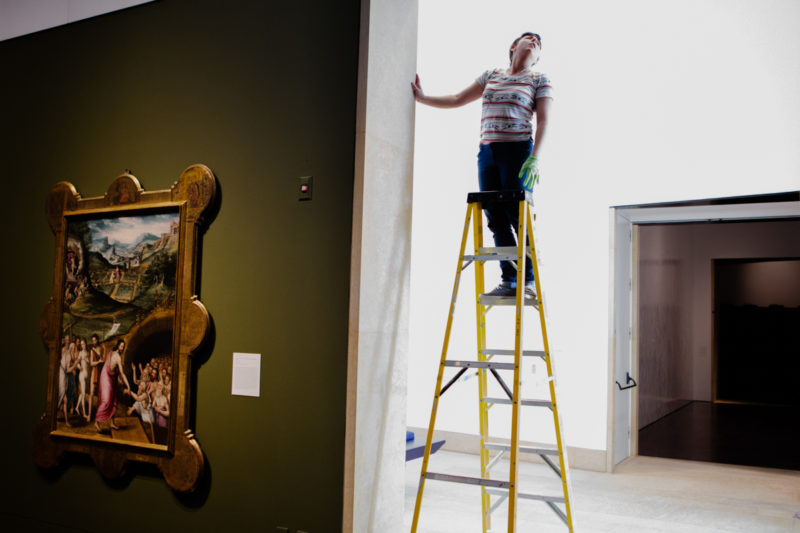Mesoamerican Artifacts Highlight Makeover at UT’s Blanton
By Mary K. Cantrell
Reporting Texas

Rebecca Marino, an art handler at the Blanton Museum, works on preparing the Mesoamerican exhibit that is reopening on Sunday, February 12, 2017. Kara Henderson/ Reporting Texas
The gallery doesn’t look like much when you walk in. An intricately carved, limestone panel graces a subdued, gray wall. Glass boxes encase 19 ceramic figurines and other ancient Mesoamerican artifacts. The lighting is precise and clean.
The new Ancient Americas gallery is a small but integral part of “Reimagining the Blanton,” the museum’s five-year makeover that opens on Feb. 12. One of numerous galleries renovated to give visitors personalized experiences, the Mesoamerican addition is the most intensely symbolic, representing 2,500 years of Latin American history in a 200-square-foot space.
Local scholars and curators consider the exhibit long overdue. The 20 items in the gallery belong to UT-Austin’s Art and Art History Collection, an assemblage estimated to contain between 4,000 and 6,000 pieces. The exhibit was partly inspired by the release of “The Collections,” a 2015 book published by UT Press that highlights the university’s holdings that often remain unknown to the public because of a lack of museum space, said Astrid Runggaldier, assistant director of the UT-Austin Mesoamerica Center.
“It’s going to be the first time these objects that have been lost within campus are finally given the attention they deserve,” said Rosario Granados-Salinas, an associate curator specializing in Spanish colonial art.
The artifacts in the exhibit represent Olmec, Maya and Aztec cultures, and showcase the diversity of ancient Mesoamerican cultures, whose peoples inhabited a region from present-day Mexico to Costa Rica. Curators selected objects for their dual functionality, such as a stone ax head adorned with a stylized human face. In cultures of the new world, said Runggaldier, “people are really a part of the natural environment, and the natural environment is as alive as people are.”
The Blanton Museum of Art has long been a national leader in contemporary Latin American art, yet the museum was missing artifacts from key periods before the 18th century that the new exhibits of the ancient Americas and Spanish Americas feature.
The Blanton’s “strength in Latin American art will come off more obviously than it has in the past,” Runggaldier said. “When you put it all together … the depth of the history of the Americas will come through a lot more clearly.”
Ancient Art of the Americas will be a permanent, rotating exhibition with old items exchanged for new ones every 18 months. Runggaldier said students in UT’s new museum studies certificate program will get to curate and display the items to get hands-on experience in undergraduate research.
Art history professor Julia Guernsey said she plans to take her 85-member class through the exhibit.
“It’s finally looking at the objects as objects of cultural value, beauty, interest … side by side other objects that are revered from other cultures like the Greek vases, or Renaissance painting,” Guernsey said.
Runggaldier said political controversies over immigration and other issues since the U.S. presidential election have made minority populations nervous about the extent to which heritage is valued, but this collection sends a message of support to people of Latin American descent. “It’s really important right now to remind people we think they do belong in this society,” she said.
Granados said walking around the museum and seeing the diversity of the collections give her hope that the Blanton is prioritizing diversity. “I have two kids that are Mexican-American, and I always have that in the back of my head, that they are a part of two cultures,” she said. “I think this installment is talking to that.”